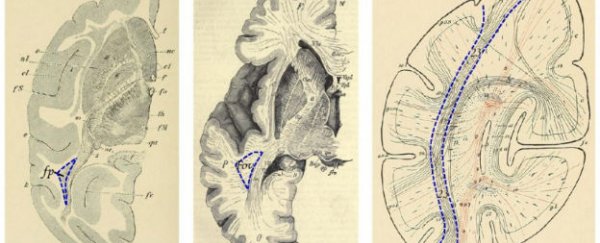Neuroscientists in the US have accidentally rediscovered a forgotten region of the brain while investigating how reading skills develop over time in children.
"We couldn't find it in any atlas," one of the team, Jason Yeatman from the University of Washington's Institute for Learning and Brain Sciences, told Laura Geggel at LiveScience. "We'd thought we had discovered a new pathway that no one else had noticed before."
What they'd found was a region that, for reasons unknown, dropped out of the scientific literature describing human brains about a century ago, but continued to have a known prescence in the brains of other primates.
First discovered in 1881 by German neurologist Carl Wernicke, region is called the vertical occipital fasciculus (VOF). This flat, 5.5-centimetre cluster of long nerve fibres running vertically along the rear of the brain was found by Wenicke during a monkey brain dissection, and while it was later found in human brains, it remained conspicuously absent from anatomical drawings called 'brain atlases' throughout history.
This is something of a major oversight, as the VOF is now thought to play a unique and crucial role in how we're able to process visual information. It maintains several connections between the nearby 'vision sub-regions' of the brain, which work together with visual cortex - also in the rear section of the brain - to process what we're seeing at any given moment.
"I stumbled upon it while studying the visual word form area," Yeatman told Mo Costandi at The Guardian. "In every subject, I found this large, vertically-oriented fibre bundle terminating in that region of the brain."
After poring through both contemporary and historic literature for mentions of the region, Yeatman says a colleague remembered having seen something like it in an old medical textbook. So he dipped into the brain atlases of the late 1800s and early 1900s to discover a bizarre squabble between some of the world's most imminent neuroscientists at the time.
It seems that Wenicke's superior, German-Austrian neuroanatomist, Theodor Meynert, more or less ignored his student's discovery, perhaps because it clashed with his own conclusions about the human brain. Meynert, who also taught none other than Sigmund Freud, had proposed a theory that said the neural pathways of the brain ran horizontally from the front of the brain to the back, not vertically, as Wenicke's new discovery appeared to do.
Or perhaps Wenicke's discovery was so removed from what Meynert was working on at the time that he ignored the discovery simply because he was focussing on something else. "Meynert's apparent non-discussion of these fibre systems may simply have reflected his interest and focus," Jeremy Schmahmann, a neurologist from the Massachusetts General Hospital and Harvard Medical School who was not involved in the study, told Geggel at LiveScience.
Add the oversight of one of the world's most respected neuroanatomists to the fact that in many of the brain atlases the VOF did turn up in, it had all kinds of different names, and that it can be very easily missed when you're dissecting a human brain, and it makes sense how Wenicke's discovery could have disappeared into obscurity.
Now that they've found it, Yeatman's team has scanned over 70 people to locate and map the VOF properly, and the findings have been published today in the Proceedings of the National Academy of Sciences.
According to Costandi at The Guardian, the team describe the VOF as connecting the 'upper' and 'lower' streams of the brain's visual pathway. "The lower stream connects brain regions involved in processes such as object recognition, including the fusiform gyrus, and the upper stream connects the angular gyrus to other areas involved in attention, motion detection, and visually-guided behaviour," she says.
Yeatman and his team are continuing their research into how learning to read impacts a young person's brain structure, and he says he thinks there's a good chance that the newly rediscovered VOF will play a crucial role in that work.
Sources: LiveScience, The Guardian
